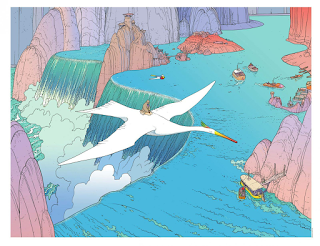Week #9

Moebius This week, I read Blueberry by Moebius. The first reason I chose his work was that I saw the title, “Miyazaki/Moebius: A Joint Exhibition Catalogue” in the course resource page. I did not know Hayao Miyazaki collaborated with Moebius. I wanted to know how Miyazaki was influenced by Moebius’ work. When I started reading Blueberry (The trail of the Sioux), it reminded me of the conversation I had with the members of ITEC, which is an theme park design company came to the campus last week. They had experiences of working on European theme parks; and they said, “it is surprising how popular the Old West theme is in Europe. They love cowboys and such!” Therefore, it is understandable that Blueberry is one of the most famous works by Jean Gir (Moebius). However, reading through Blueberry, I realized that the story is not similar to those generic Western themed stories; Blueberry is not a stereotypical cowboy/gunman who suddenly appe...